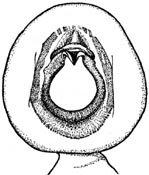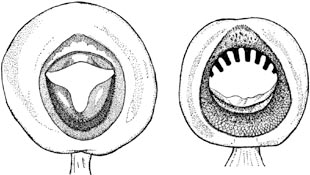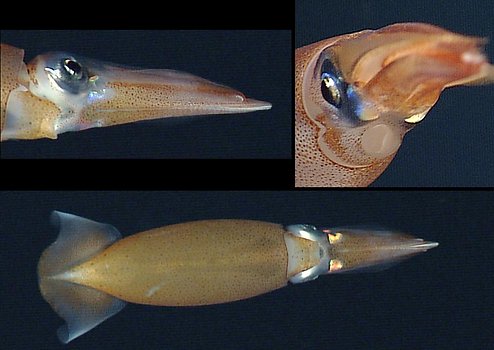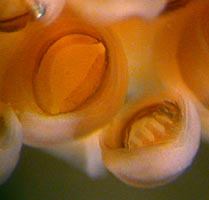Berryteuthis anonychus
Tsunemi Kubodera, F. G. Hochberg, and Richard E. YoungIntroduction


Figure. Ventral view of B. anonychus, ventral view of male, 69 mm ML, preserved. Photograph by R. Young.
Berryteuthis anonychus is a small, muscular species reaching a maximum size of 150 mm ML (Nesis, 1982/87). This squid has been repeatedly captured by dipnet at the surface at night. B. anonychus is unusual for a gonatid in lacking nearly all hooks on arms and tentacle clubs.
Diagnosis
A Berryteuthis ...
- without hooks on arms in males.
- with few weakly developed hooks at bases of arms I-III in females.
Characteristics
- Arms
- Marginal arm suckers pedicillate; sucker rings with 6-8 truncate, rectangular teeth.
- Arms of males without hooks; sucker rings in medial 2 rows of basal two-thirds to three-quarters of arms consist of dorsal and proximal lips not distinct and separate teeth.
- Females with 3 pairs of small, hook-like suckers present in medial rows at proximal region of arms; arm hooks develop at mantle lengths between 35-60 mm ML.
- Hectocotylized arms not present.
 Click on an image to view larger version & data in a new window
Click on an image to view larger version & data in a new window

Figure. Oral view of arm suckers and hooks of B. anonychus. Left - Medial hook-like sucker, basal portion of arm III, female. Middle - Medial sucker, basal two thirds of arm III, male. Right - Marginal sucker from arm III. Drawings from Pearcy and Voss (1963).
- Head
- Beaks. Descriptions can be found here: Lower beak; upper beak. See also this site.
- Unidentified structure. In situ observations of B. anonychus indicate that this squid strongly reflects artificial lights near the anterior edge of the eye and base of the ventral arms. The reflection is noticeable when the squid's anterior or ventral aspect is directed toward the lights. The structures on the squid responsible for this reflection are unknown.
 Click on an image to view larger version & data in a new window
Click on an image to view larger version & data in a new window
Figure. Various views of two B. anonychus showing reflective structures near head. Top left - Ventrolateral view of head. Top right - Anterolateral view of head. Bottom - Ventral view of head. The photographs were taken from an MBARI ROV off Oregon (USA) at depths of 1450 m and 1114 m. Photographs © 2013 MBARI.
Comments
Information on most characters listed above taken from Pearcy and Voss (1963).
More details of the description of B. anonychus can be found here.
Life History
Paralarvae can be identified by the dorsal-head chromatophore pattern which is Type II,2 (three transverse rows of chromatophores with one chromatophore in the anterior row, two in the middle row and three in the posterior row and two additional chromatophores on the posterolateral regions of the head but are visible dorsally); the mantle has 16-25 dorsal chromatophores (Jorgensen, 2006).


Figure. Dorsal views of the chromatophores of a B. anonychus paralarva, 5.5 mm ML, Gulf of Alaska. Left - Head. Note the two additional dark chromatophores on the posterolateral corners of the drawing. Right - Paralarva. Drawing from Jorgensen (2007).
Behavior
In the posture shown below, which we call a Parachute posture, B. anonychus remains virtually motionless. The orientation of the fins, body, arms and tentacles would seem to produce maximum resistance to sinking.

Figure. Combination of two photographs showing the same B. anonychus from different viewpoints (top - nearly side view, bottom - nearly posterior view). The photographs were taken from an MBARI ROV off Oregon (USA) at 1450 m depth. Photographs © 2013 MBARI
Distribution
Type locality: Eastern North Pacific Ocean, USA, off Oregon, 45 27.0'N, 125 15.6'W, surface (0 m).References
Jorgensen, E. M. 2007. Identification, distribution and relative abundance of paralarval gonatid squids (Cephalopoda: Oegopsida: Gonatidae)from the Gulf of Alaska, 2001-2003. Journ. Molluscan Studies, 73: 155-165.
Katugin, O.N. 2004. Squids of the family Gonatidae from the North Pacific Ocean and their genetic differentiation: controversial issues in the systematics and phylogeny. Ruthenica, 14(1): 73-87 [In Russian, English summary]
Katugin, O.N., G.A. Shevtsov, M.A. Zuev, A.M. Berkutova and E.V. Slobodsky. 2005. Spatial and seasonal distribution of the squid Okutania anonycha (Pearcy et Voss, 1963) (Cephalopoda: Gonatidae) in the northwestern Pacific Ocean and adjacent areas. Ruthenica, 15(1): 65-79.
Lindgren, A.R., O.N. Katugin, E. Amezquita and M.K. Nishiguchi. 2005. Evolutionary relationships among squids of the family Gonatidae (Mollusca: Cephalopoda) inferred from three mitochondrial loci. Molecular Phylogenetics and Evolution, 36: 101–111
Nesis, K.N. 1973. Taxonomy, phylogeny, and evolution of squids of the Family Gonatidae (Cephalopoda). Zoologicheskij Zhurnal, 52(11): 1626-1638 [In Russian, with English summary].
Nesis, K.N. 1997. Gonatid squids in the subarctic north Pacific: ecology, biogeography, niche diversity and role in the ecosystem. Advances in Marine Biology, 32: 243-324.
Nesis, K. N. (1982). Abridged key to the Cephalopod Mollusks of the World's Ocean. 385+ii pp. Light and Food Industry Publishing House, Moscow. (In Russian.). Translated into English by B. S. Levitov, ed. by L. A. Burgess (1987), Cephalopods of the World. T. F. H. Publications, Neptune City, NJ, 351 pp.
Okutani, T., T. Kubodera and K. Jefferts. 1983. Diversity, distribution and ecology of gonatid squids in the subarctic Pacific: a review. Bull. Ocean Res. Inst., Univ. Tokyo, No. 26 (1): 150-192.
Pearcy, W. G. and G. L. Voss. 1963. A new species of gonatid squid from the northeastern Pacific. Proc. Biol. Soc. Wash., 76: 105-112.
About This Page

National Science Museum, Tokyo, Japan
F. G. Hochberg

Santa Barbara Museum of Natural History, Santa Barbara, California, USA

University of Hawaii, Honolulu, HI, USA
Page copyright © 2015 , F. G. Hochberg, and
 Page: Tree of Life
Berryteuthis anonychus .
Authored by
Tsunemi Kubodera, F. G. Hochberg, and Richard E. Young.
The TEXT of this page is licensed under the
Creative Commons Attribution-NonCommercial License - Version 3.0. Note that images and other media
featured on this page are each governed by their own license, and they may or may not be available
for reuse. Click on an image or a media link to access the media data window, which provides the
relevant licensing information. For the general terms and conditions of ToL material reuse and
redistribution, please see the Tree of Life Copyright
Policies.
Page: Tree of Life
Berryteuthis anonychus .
Authored by
Tsunemi Kubodera, F. G. Hochberg, and Richard E. Young.
The TEXT of this page is licensed under the
Creative Commons Attribution-NonCommercial License - Version 3.0. Note that images and other media
featured on this page are each governed by their own license, and they may or may not be available
for reuse. Click on an image or a media link to access the media data window, which provides the
relevant licensing information. For the general terms and conditions of ToL material reuse and
redistribution, please see the Tree of Life Copyright
Policies.
- First online 31 May 2006
- Content changed 11 October 2015
Citing this page:
Kubodera, Tsunemi, F. G. Hochberg, and Richard E. Young. 2015. Berryteuthis anonychus . Version 11 October 2015. http://tolweb.org/Berryteuthis_anonychus/26874/2015.10.11 in The Tree of Life Web Project, http://tolweb.org/













 Go to quick links
Go to quick search
Go to navigation for this section of the ToL site
Go to detailed links for the ToL site
Go to quick links
Go to quick search
Go to navigation for this section of the ToL site
Go to detailed links for the ToL site